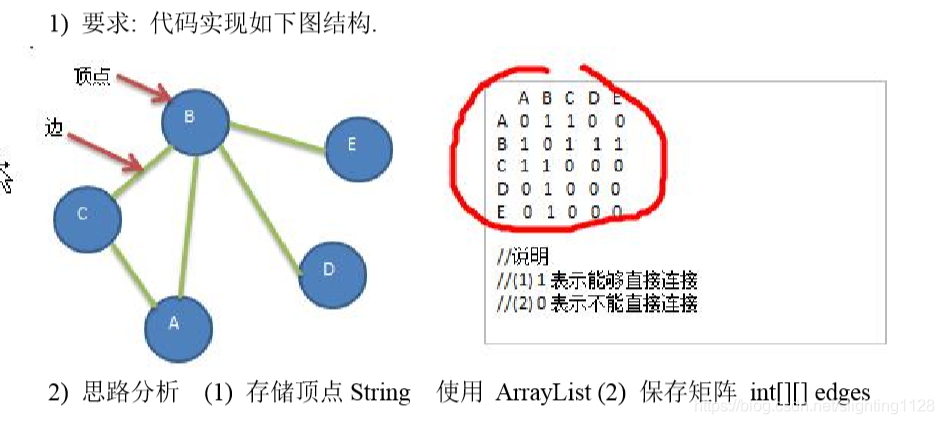图

一、优先遍历


二、代码
1.Graph
代码如下(示例):
Graph;
//使用二维矩阵来表示图
import java.util.ArrayList;
import java.util.Arrays;
import java.util.LinkedList;
public class Graph {
//用链表表示其中的节点的数据
public ArrayList<String> VertexList;
public int[][] edges;
public int numofedge;
//深度优先遍历(dfs)中看每个节点被访问没
public boolean[] isVisited;
//添加一个构造方法初始化图
public Graph(int num) {
VertexList = new ArrayList<String>(num);
edges = new int[num][num];
numofedge = 0;
isVisited = new boolean[num];
}
//找到当前节点的最近的节点
/**
* @param i 从当前节点开始查找出相邻节点
* @return 找到返回该结点的下标,没有则返回-1
*/
public int getFirstNeighbor(int i) {
for (int j = 0; j < VertexList.size(); j++) {
if (edges[i][j] > 0) {
return j;
}
}
return -1;
}
//找到当前节点的另外一个临接节点
/**
* @param i 表示当前节点
* @param v1 表示领临接节点的下一个节点
* @return 找到返回下标,没有返回-1
*/
public int getNextNeightbor(int i, int v1) {
for (int j = v1 + 1; j < VertexList.size(); j++) {
if (edges[i][j] > 0) {
return j;
}
}
return -1;
}
//深度优先遍历算法
public void dfs(boolean[] isVisited, int n) {
System.out.print(getVertex(n) + "->");
//将这个节点设置为true
isVisited[n] = true;
//查找这个节点的第一个临接节点w
int w = getFirstNeighbor(n);
while (w != -1) {
if (isVisited[w] == false) {
dfs(isVisited, w);
}
w = getNextNeightbor(n, w);
}
}
//对dfs算法进行一个重载,遍历非联通图,遍历所有节点
public void dfs() {
for (int i = 0; i < getNumofVertex(); i++) {
if (isVisited[i] == false) {
dfs(isVisited, i);
}
}
}
//广度优先算法
public void bfs(boolean[] isVisited, int n) {
//构建一个LinkedList集合,模拟队列
LinkedList<Integer> Queue = new LinkedList<>();
isVisited[n] = true;
Queue.addLast(n);
while (Queue.size() != 0) {
int u = Queue.removeFirst();
int w = getFirstNeighbor(u);
if (w != -1) {
if (isVisited[w] == false) {
System.out.print(getVertex(w));
isVisited[w] = true;
Queue.addLast(w);
}
w = getNextNeightbor(u, w);
}
}
}
//对bfs算法进行一个重载,遍历非联通图,遍历所有节点
public void bfs() {
for (int j = 0; j < getNumofVertex(); j++) {
if (isVisited[j] == false) {
bfs(isVisited, j);
}
}
}
//添加节点到VertexList中
public void InsertVertex(String Vertex) {
VertexList.add(Vertex);
}
//添加边的信息
public void InsertEdge(int n1, int n2, int weight) {
//无向图
edges[n1][n2] = weight;
edges[n2][n1] = weight;
numofedge++;
}
//返回定点数
public int getNumofVertex() {
return VertexList.size();
}
//返回边数
public int getNumofedge() {
return numofedge;
}
//返回节点i对应的字符串值 0->'A'
public String getVertex(int i) {
return VertexList.get(i);
}
//返回2个节点对应的权重
public int getweight(int n1, int n2) {
return edges[n1][n2];
}
//打印整个图
public void show() {
for (int[] row : edges) {
System.out.println(Arrays.toString(row));
}
}
}
2.Demo
代码如下(示例):
package Graph;
public class GraphDemo {
public static void main(String[] args){
int n =5; //节点的个数
String[] Vertex = {
"A","B","C","D","E"};
Graph graph = new Graph(5);
for (String s:Vertex) {
graph.VertexList.add(s);
}
graph.InsertEdge(0,1,1);
graph.InsertEdge(0,2,1);
graph.InsertEdge(1,2,1);
graph.InsertEdge(1,3,1);
graph.InsertEdge(1,4,1);
graph.show();
//graph.dfs();
graph.dfs();
}
}
总结
按步骤来写